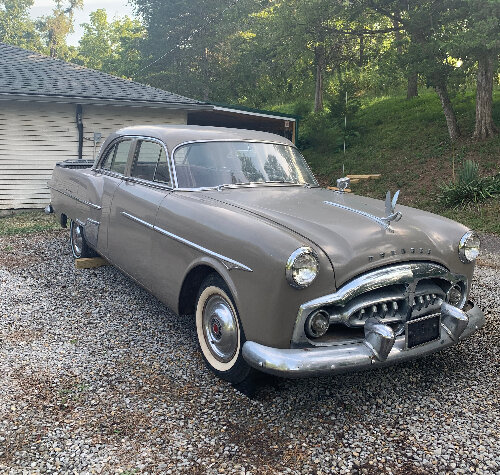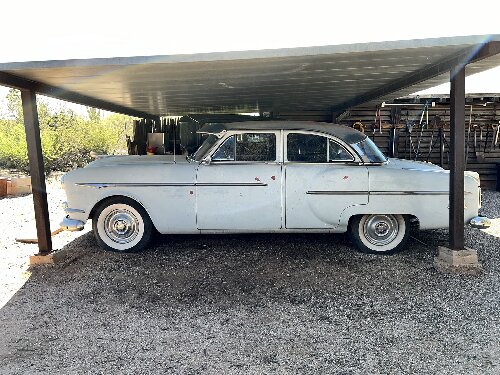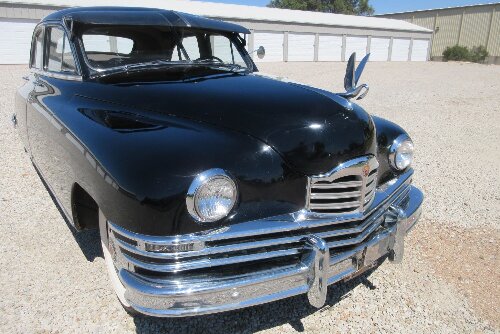|
Re: Continuing the Packard
|
||||
|---|---|---|---|---|
|
Home away from home

|
Hi
This was written mostly for the other thread, but I'll post it here since it's on the subject. I've been following this intriguing thread, here's my ten cents. By 1960, AMC had pretty well mined the rich market vein as the only domestic economy car maker to stunning success, Studebaker notwithstanding. Henceforth, the Big Three's compacts would erode the AMC market share unless they found some additional features or qualities which would retain their customer base as well as attract new adherents. Styling alone couldn't do it, every compact had to be pleasant, grand-but-bland and non-controversial. The tyranny of annual styling changes would consume precious dollars better spend elsewhere. Fortunately, beginning with 1961, Lincoln was championing a new approach which would also have served AMC much better long term. The AMC manufacturing structure and dealer network was largely uniform with the industry, its unit-cost/retail price relationship would have to stay within the established Big Three and imports regimen. Not much leeway gain to a market advantage. The main aspects the Big Three seemed glad to ignore in their compacts were overall build quality, fit and finish and engineering for long-term durability; only VW took these seriously, followed by the Japanese. This could have also been the AMC ace-in-the-whole. How would Packard fit into this? An astute AMC management would have noticed the only other success car concurrent to 1958-60 was the Ford Thunderbird. Like Rambler, it bucked the '58 recession, racking up impressive sales gains, then settled into respectable volumes. The intangible benefit was the luster it brought to other Fords. True, AMC had their Rambler deluxe in Ambassador. But as Chrysler was coming to understand, it like Imperial would never be accepted as a stand-alone luxury make after decades of life as a model name. Still, there was an opportunity for AMC to participate in that segment with a careful, long-term approach which could include Packard. The first step would have been to quietly acquire rights to the name, trademarks, any design patents which Studebaker Corporation still held, keeping rumors of a sudden Packard revival from developing. The next step beginning with the all-new '63 Rambler line would be to follow a practice of minimal annual styling updates teamed with continual, rigorous overall build quality and long-term durability improvements drive into each succeeding year. The point would be to learn how to cost-effectively include those aspects into lower-priced cars by internalized them as standard operating procedure. The objective would be to lift customer perceptions of AMC cars as far more than "off-brand, cheap, junky little Ramblers"; a reputation a goodly percentage of the population held. As the decade progressed, avoiding the short-term costly blind alleys such as the Marlin, Javelin and AMX as well as major costly restyles for basic lines, might have freed up some of the funding needed to make this succeed. All this would have demanded considerable expense and commitment, perhaps more than such a small carmaker could have borne. After four to five years of careful engineering wrapped in a design by first-class talents such as Exner, Teague and others, built in a separate, state-of-the-art production facility supported by commitment to build the only best, only would then Packard have been re-launched as a new personal sport-luxury make. The line would be simply a sports sedan, hardtop coupe and convertible. It would share internal Ambassador structures including the immediate width, but paired with long hood/short deck proportions as Paul has shown. In marketing, only large, urban AMC dealers would have the chance to participate with separate, brand-new Packard dealerships facilities. It would not be sold at the AMC/Rambler outlets unless the dealer had demonstrated the commitment to the totally different approach which the luxury market demanded. Something of a similar approach Toyota took decades later with Lexus. Perhaps AMC would also allow franchises to dealers already selling high-end import makes. Sound plausible? Steve
Posted on: 2012/8/30 18:35
|
|||
|
||||
|
Re: Continuing the Packard
|
||||
|---|---|---|---|---|
|
Just can't stay away

|
OK, here we go:
Studebaker Leadership: Harold S. Vance, Paul G. Hoffman Product: Champion, Commander, Land Cruiser Factory: South Bend, Indiana Packard Leadership: James J. Nance Product; Clipper, Packard, Patrician, Carribean Factory: Detroit, Michigan Hudson Leadership: Abraham Barit Product: Wasp, Hornet, Jet, Italia Factory: Detroit, Michigan Nash Leadership: George Mason, George Romney Product: Statesman, Ambassador, Rambler, Metropolitan, Nash-Healey Factory: Kenosha, Wisconsin Kaiser-Willys Leadership: Henry J. Kaiser Product: Special, Manhattan, Kaiser-Darrin, Henry J, Willys Aero, Jeep Factories: Willow Run, Michigan & Toledo, Ohio Sure, there's a LOT more pieces of the puzzle than this . . . Who had what for engines, who were the stylists and engineers they brought to the table, and what kind of shape were they in to start with? Feel free to jump in. Let's see if we can save Packard! P.S. - Steve, just read your post after I finished typing and posting the above. All good points, and I also had noticed the phenomenon of the 1958 Thunderbird bucking the Eisenhower Recession. I have had some reservations about the AMC dealers being able to effectively market a Packard, but you have shown one possible way it might have been done.
Posted on: 2012/8/30 18:48
|
|||
|
||||
|
Re: Continuing the Packard
|
||||
|---|---|---|---|---|
|
Home away from home

|
Fyreline - thanks for starting this thread and laying out the starting parameters. I had forgotten some of those Studebaker names in particular.
Steve - excellent storyline that not only works Packard back in but perhaps more importantly, gets AMC onto more solid footing. I think your suggestions are perfectly plausible and not at all tainted by hindsight. People today sometimes don't realize the enormous amount of data that was available to the OEM leaders back then. In that box of Special Interest Autos you generously sent me earlier this year I recall reading an interview with George Romney where he discussed, in great detail, his mindset and that of Nash back in the 1946-56 timeframe about where the industry was headed. He said Nash's market researchers had gathered a tremendous amount of data back in the 40s on consumer interest in a small car, and the leadership fully understood the would-be Rambler's potential. He also had specific thoughts on where he thought the big Nash was headed (nowhere). What he was really saying was "WE OEM LEADERS LOOK AHEAD, ENVISION AND PLAN". So your line of reasoning is not only plausible but should have been expected of any OEM leadership team at that time. Now having said that, and reflecting on my earlier comments that probably unfairly panned the Javelin/AMC decision, it should be noted that AMC and the rest of the industry was watching beginning in mid-1964 as Ford was literally printing money with the Mustang. I can't take too much issue with AMC's wanting to go after a piece of that pie. I take major issue with their execution of the product. If they couldn't afford to go all in and change everything needed, particularly the proportions, to compete with the Mustang they should have never tried. As it turned out, Javelin's differentiation from the American was about as extensive as the 2nd gen Barracuda... and about as successful. Camaro and Firebird spent big to get the full changes needed to compete and GM along with Ford pulled that much further ahead of AMC. There has been a fair amount of less than accurate historical material written about AMC's downfall and how the big cars were to blame when in fact, AMC failed because they dropped the ball everywhere and it was actually Ambassador sales in the late 60s that held up pretty well compared to the rest of the line-up. I would venture to say they were either profitable or nearly so, not surprising since they were basically Rebels with an extended hood. This was the very same strategy Romney used with the 1958 Ambassador and nobody ever took issue with that. Off soap box, on mountain top looking back. Here's one idea for a successful AMC-SP relationship. I try not to assume impossibilities such as Mason surviving or Romney and Nance liking each other. What I have concluded is that merger was never going to happen for these two companies in this time period and would have to wait several years, but Romney's proposal to Nance in late 1954/early 1955 for "love without marriage" was perfectly plausible. As a setup to my argument for the type of marriage needed let me first point out that Nance apparently found Romney's specific proposal unworkable for several reasons, amongst them the need to negotiate on literally every part shared. Romney, on the other hand, was losing patience with Nance for not reciprocating on AMC's using, and helping to pay for, Packard's V8. Romney wanted Packard to buy Nash's body shells. Big N-O from Packard on that one and I can't blame Nance. Who in their right mind would want to use that body for a Packard, even if it was a Clipper? Packard would end up with a dorky product and lose the economies of scale it gained sharing Clipper and Packard bodies. The whole thing ended in a stand still. Here's one way it could have moved forward. To lay this out, I think it is important to clearly state what everyone wanted, didn't want and, in the case of Nance, was in a position to offer. And this list unfortunately must include Studebaker because Nance's merger gave them too much Board control. I also don't try to break up the Nash/Hudson nor the Studebaker/Packard sales outlets and try to realign as Studebaker/Nash and Hudson/Packard. Not only was this unlikely without a full merger but the ship had likely already sailed, not so much by lots of dealers having actually dueled by then but because both Romney and Nance had their individual reasons for keeping things status quo. Timeframe: early 1955 What DID... Romney want? - Focus on small cars (saw greater potential than with large cars) - More reciprocity from S-P vis-?-vis V8, such as body sharing - Possible abandonment of Nash large car platform - Increased dealer network through acquisition of Hudson to help increase sales The S-P Board (i.e. Studebaker) want? - Continued South Bend operations - S-P profitability - To continue to be pains in the @ss! Nance want? - Relief from Studebaker losses by closing South Bend, similar to how Hudson was quickly closed (by now Nance KNEW the numbers) - An inexpensive depression-proof car for his Packard dealers What DIDN'T... Romney want? - Full merger with S-P - Insufficient reciprocity from S-P vis-?-vis the V8 Nance want? - Romney's Love Without Marriage Proposal #1 (Packard buys Nash large bodies, negotiation on every part) What COULD... Nance offer Romney? - Nash builds the 1956 Studebaker based on the new 1956 Rambler, shutting down car production in South Bend - Packard builds the 1957 Hudson based on new Packard, allowing Romney to have a big car without the burden of engineering and building it - Packard builds the V8 and Twin-Ultramatic for the large Hudson Nance offer Studebaker? - Studebaker continues to engineer and build Studebaker trucks in South Bend - Studebaker-badged (but not built) vehicles continue to be sold at Studebaker dealerships - Basic corporate survival in lieu of a very ugly disengagement with Packard TIMELINE Actual Historical Timeline 1/54 - AMC formed (Mason CEO) 10/54 - Mason passes, Romney becomes CEO 10/54 - Studebaker/Packard formed (Nance CEO) 10/54 - Hudson body operations end 2/55 - Hash introduced 2/55 - Studebaker's financial mess fully understood 2/55 - AMC and S-P both losing money Proposed Additional Timeline 3/55 - Nance proposes new Love Without Marriage plan to Romney and Studebaker Board 4/55 - Romney agrees 5/55 - Studebaker Board agrees 10/55 - Studebaker passenger car production ends in South Bend and elsewhere 1/56 - Rambler-based Studebaker production begins in Kenosha, WI 1/56 - Packard 4HT and Executive introduced 1/57 - New Predictor-based Packard and Hudson vehicles launched at Conner Ave LINE-UP 1955 Line-Up Nash Rambler/Hudson Rambler (Platform: Rambler) Nash Statesman-Ambassador/Hudson Wasp-Hornet (Platform: Statesman-Ambassador) Studebaker (Platform: Studebaker) Clipper/Packard (Platform: Packard) 1956 Line-Up Nash Rambler/Studebaker (Platform: New Rambler) Nash Statesman-Ambassador/Hudson Wasp-Hornet (Platform: Statesman-Ambassador) Clipper/Packard (Platform: Packard) (4HT added) 1957 Line-Up Nash Rambler/Studebaker (Platform: New Rambler) Hudson/Packard (Platform: New Packard) OTHER FACTORS Key to Success: S-P ends South Bend car production before the losses cripple the entire company. Risks: Would S-P have waited too long to shut down South Bend car production? Would Romney have trusted Nance to get the quality right on the new Hudson? Would Nance have been able to raise capital? Would all these new designs resonate with the public? Kaiser: so long, farewell, alveterzane goodbye... Thoughts? Other proposals?
Posted on: 2012/8/30 20:57
|
|||
|
||||
|
Re: Continuing the Packard
|
||||
|---|---|---|---|---|
|
Home away from home

|
Very interesting takes on the future of Packard. I would like to throw this supposition into your mix. I have read in several different sources that Walter Ruether was the only management type in Detroit to understand the auto business.
What outcome does anyone see with Ruether taking as CEO of S-P?
Posted on: 2012/8/30 21:31
|
|||
|
Stephen
|
||||
|
||||
|
Re: Continuing the Packard
|
||||
|---|---|---|---|---|
|
Forum Ambassador
|
Wasn't there some big egos and tremendous personality clashes amongst some of the individuals. I think it might have hindered any further combination unless one or more were completely out of the picture.
IIRC, at least one of the histories mentioned one of the main reasons the two mergers were arranged the way they were before the ultimate folding together was because of mistrust or outright dislike between some of the key players. After Mason died, believe it was Nance and Romney who were two of the more contentious, neither willing to play second fiddle to the other.
Posted on: 2012/8/30 21:57
|
|||
|
Howard
|
||||
|
||||
|
Re: Continuing the Packard
|
||||
|---|---|---|---|---|
|
Home away from home

|
What was the time line on Curtiss Wright of Canada acquiring SP ???? That may have had a big impact on the mergers as to who merged and who didn't.
Posted on: 2012/8/30 22:03
|
|||
|
VAPOR LOCK demystified: See paragraph SEVEN of PMCC documentaion as listed in post #11 of the following thread:f
https://packardinfo.com/xoops/html/modules/newbb/viewtopic.php?topic_id=7245 |
||||
|
||||
|
Re: Continuing the Packard
|
||||
|---|---|---|---|---|
|
Home away from home

|
Quote:
"- Increased dealer network through acquisition of Hudson ..." Gufwa ha ha ha That's about like saying Zero + Zero = Zero.
Posted on: 2012/8/30 22:07
|
|||
|
VAPOR LOCK demystified: See paragraph SEVEN of PMCC documentaion as listed in post #11 of the following thread:f
https://packardinfo.com/xoops/html/modules/newbb/viewtopic.php?topic_id=7245 |
||||
|
||||
|
Re: Continuing the Packard
|
||||
|---|---|---|---|---|
|
Home away from home

|
There were big egos, that's why I tried to keep them unmerged and each still in charge. They both were open to sharing and that was the key thing needed.
Romney said in a later interview that one of the biggest benefits of merging with Hudson was the expanded dealer network that it brought and he credits this with AMC's being able to sell so many Ramblers in the late 50s/early 60s. Who was Walter Ruether? The name sounds familiar, will need to bone up on him... very interesting proposal. Was he available?
Posted on: 2012/8/31 6:21
|
|||
|
||||
|
Re: Continuing the Packard
|
||||
|---|---|---|---|---|
|
Home away from home

|
Ah, of organized labor fame. My guess is that Reuther would not have brought himself to make the tough decisions to close plants, which might have been the only way S-P could have survived late '55 - early '56. They were bleeding cash and destroying their chances to raise capital for the '57s, and needed to do something drastic.
Also, did he have a product vision? Without that there was no future.
Posted on: 2012/8/31 8:19
|
|||
|
||||








